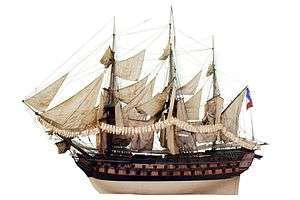French ship Polonais (1808)
 Scale model of Achille, sister ship of French ship Polonais (1808), on display at the Musée de la Marine in Paris. | |
| History | |
|---|---|
| Name: | Polonais |
| Namesake: | |
| Ordered: | 25 February 1804 |
| Builder: | Lorient |
| Laid down: | 4 July 1804 |
| Launched: | 27 May 1808 |
| Commissioned: | 25 July 1808 |
| Renamed: | Lys, 1814 |
| Struck: | 1822 |
| Fate: | Broken up, 1825 |
| General characteristics [1] | |
| Class and type: | Téméraire-class ship of the line |
| Displacement: |
|
| Length: | 55.87 metres (183.3 ft) (172 pied) |
| Beam: | 14.90 metres (48 ft 11 in) |
| Draught: | 7.26 metres (23.8 ft) (22 pied) |
| Propulsion: | Up to 2,485 m2 (26,750 sq ft) of sails |
| Armament: |
|
| Armour: | Timber |
Polonais was a Téméraire class 74-gun ship of the line of the French Navy.
First named Glorieux, she was renamed on 23 February 1807.
In 1809, under Captain Mequet, she departed Lorient, France with Troude's squadron, bound for the Caribbean. The squadron included Hautpoult and Courageux. On 29 March, the ships arrived at the Saintes and landed reinforcements.
On 29 May, Polonais and Courageux reached Cherbourg, France along with seven prize ships captured on the way. Hautpoult had been captured in the Action of 14–17 April 1809.
In April 1814, at the Bourbon Restoration, Polonais was renamed Lys captained by Troude. She then ferried Louis XVIII back to France. She was briefly renamed Polonais during the Hundred Days of Napoleon, and then back to Lys again.
After the Bourbon Restoration, Lys was sent to retake possession of the island of Martinique, along with the frigate Érigone and the corvette Vésuve. The squadron arrived at Fort Royal on 5 October 1814.[2]
From 1822, she was used as a storage hulk, and she was broken up in Brest on 1825.
References
- ↑ Clouet, Alain (2007). "La marine de Napoléon III : classe Téméraire - caractéristiques". dossiersmarine.free.fr (in French). Retrieved 14 April 2013.
- ↑ Roche, Jean-Michel (2005). Dictionnaire des bâtiments de la flotte de guerre française de Colbert à nos jours, 1671–1870. Group Retozel-Maury Millau. p. 461. ISBN 978-2-9525917-0-6. OCLC 165892922.
- Roche, Jean-Michel (2005). Dictionnaire des bâtiments de la flotte de guerre française de Colbert à nos jours, 1671–1870. Group Retozel-Maury Millau. p. 356. ISBN 978-2-9525917-0-6. OCLC 165892922.